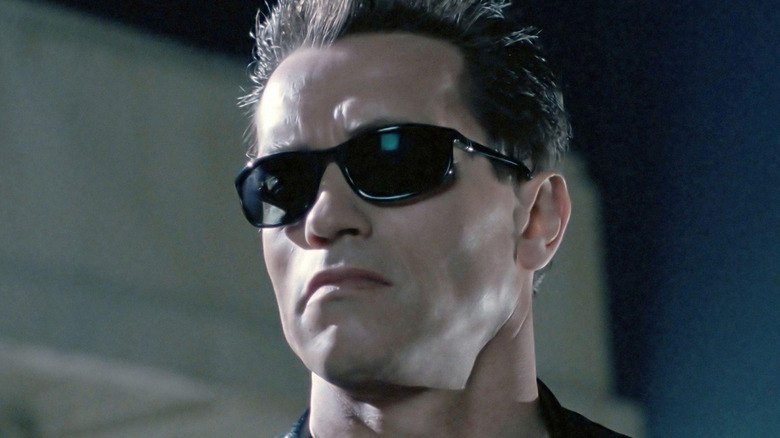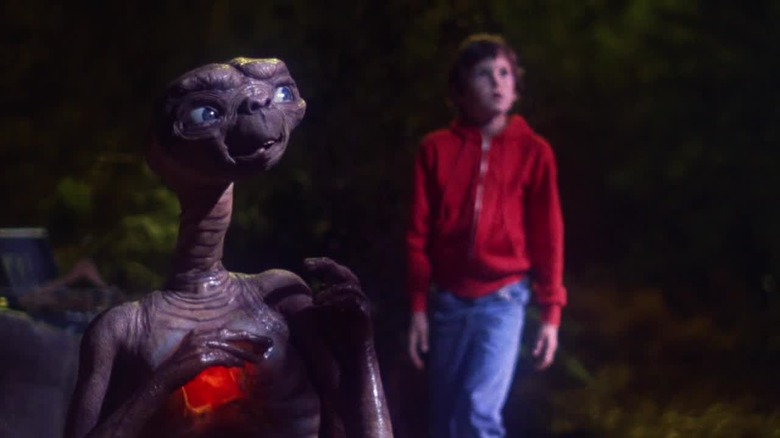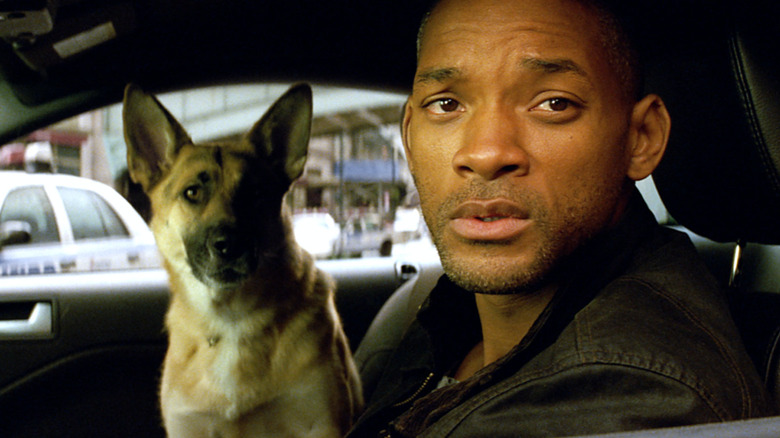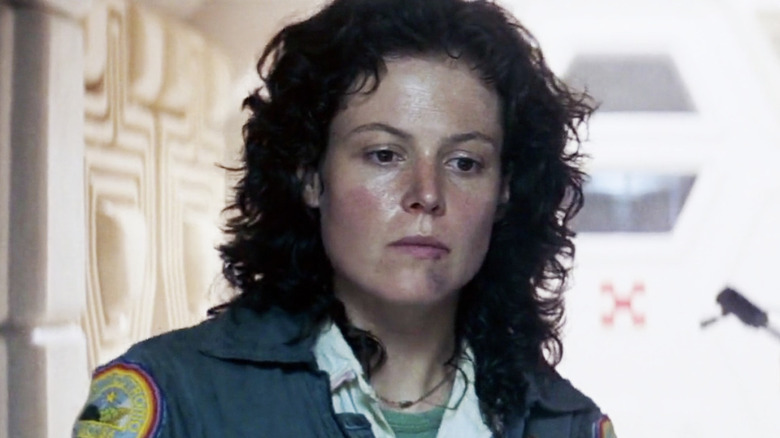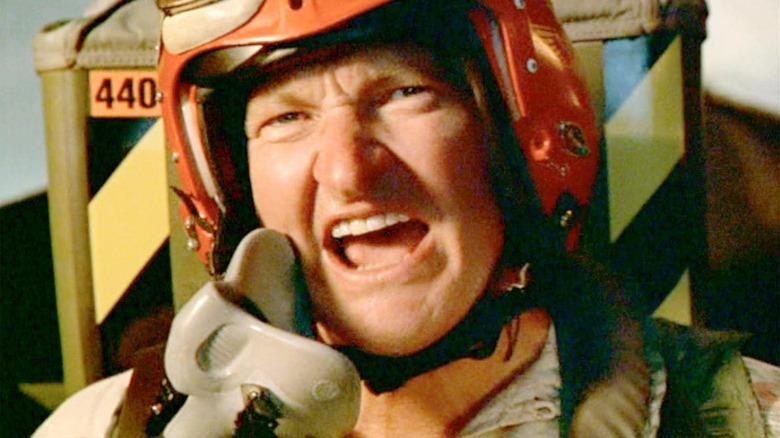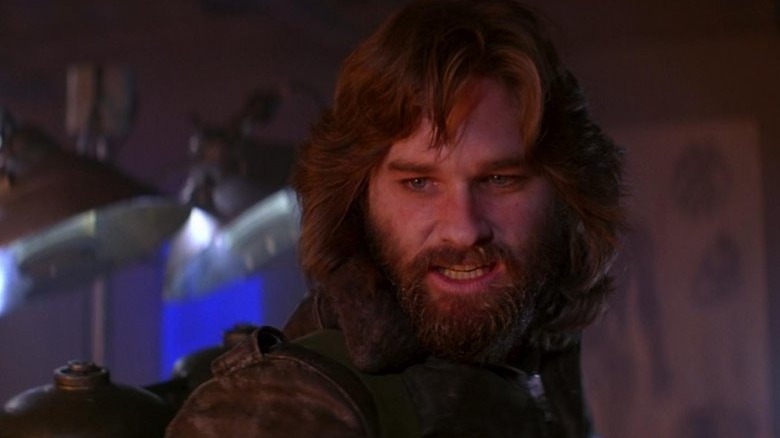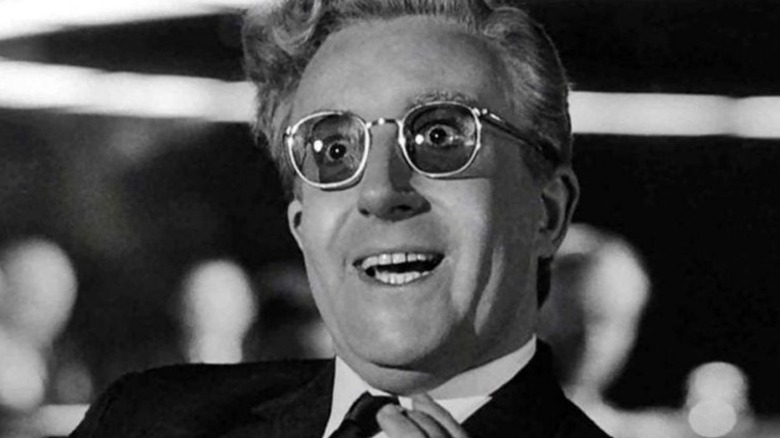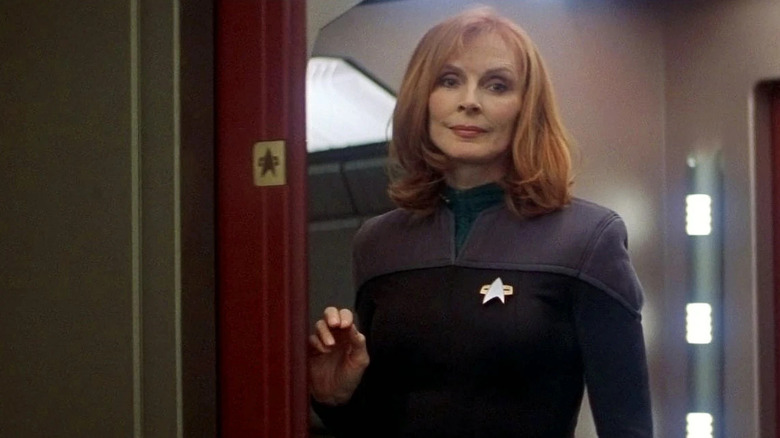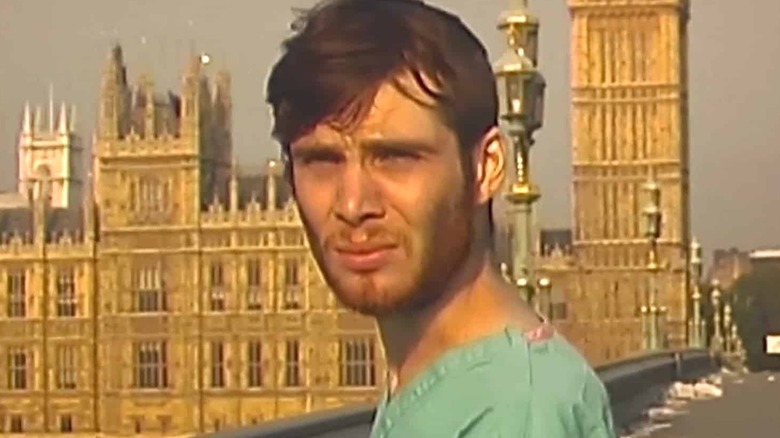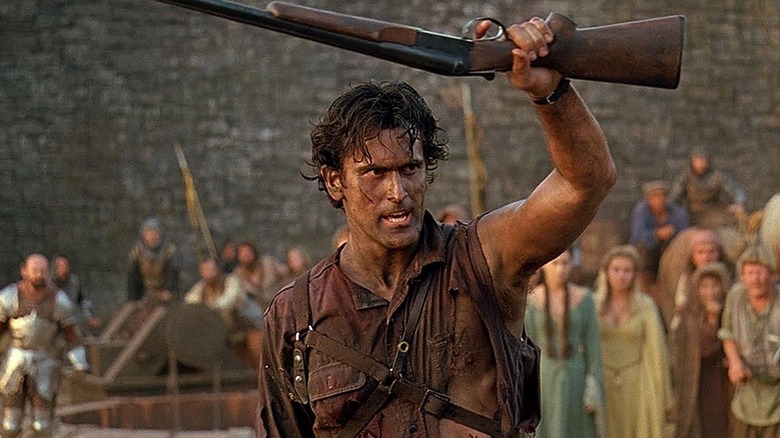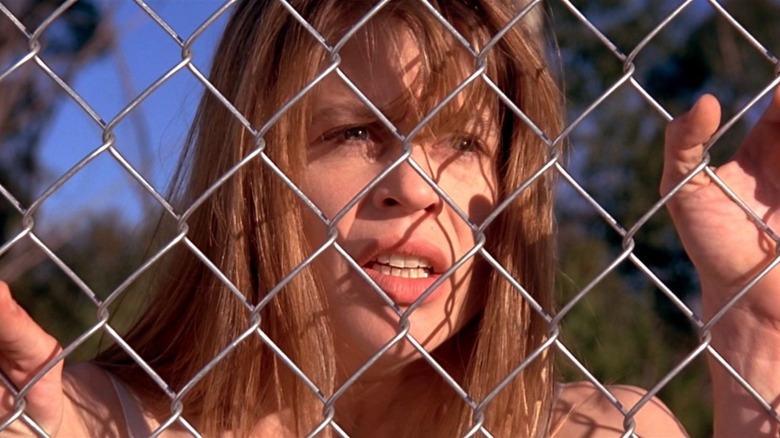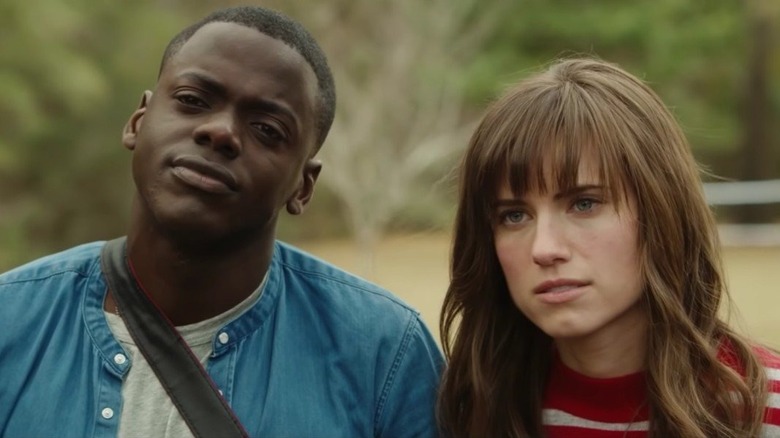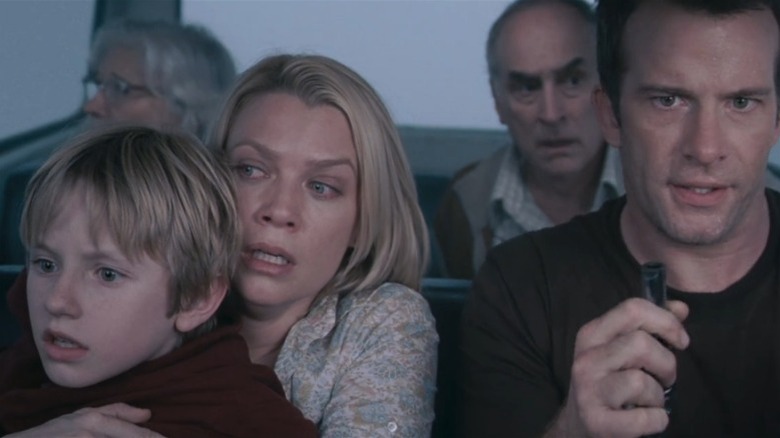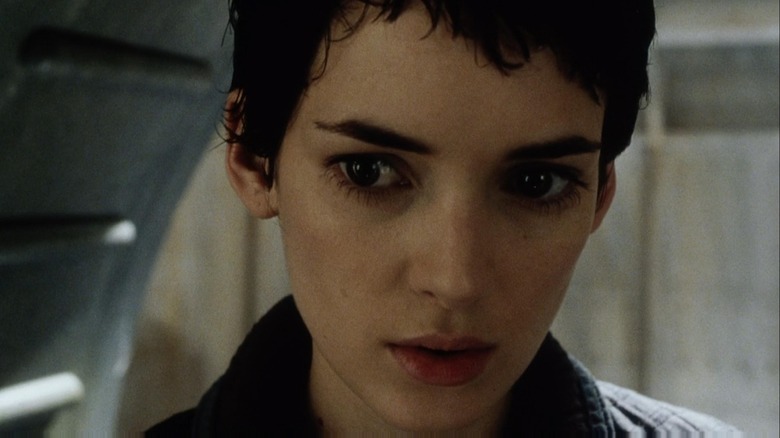Secret Sci-Fi Endings You Never Knew About
All movies need a solid, satisfying ending, but in science fiction it's doubly important. Whether it's due to a shocking twist, a stunning reveal or reversal, or just a clever and intriguing idea that ties up the mind-bending story or outer-space adventure, the ending can often make or break the movie.
For that reason, many makers of sci-fi classics have spent more time on making sure they stick the landing. As a result, they often write, storyboard, or even film alternate endings that never make it to the screen. Sometimes it's because the studio wants something different — often pushing back against a director's vision of a grim, depressing ending — and other times it's the filmmakers just testing out other ideas. Maybe they just aren't sure if they should kill off an important character or let them live to see a sequel. At any rate, these cut conclusions have given us plenty to chew on, so let's dive in for a rundown of secret sci-fi endings you never knew about.
E.T. the Extra Terrestrial
A quintessential '80s family film, Steven Spielberg's "E.T. the Extra-Terrestrial" tells the story of Elliott (Henry Thomas), a little boy who befriends an alien creature stranded on Earth. While Elliot struggles to keep his alien friend a secret, E.T. searches for a way to return home, eventually building a communicator that draws his people to Earth. In the heartstring-pulling finale, E.T. is rescued from government agents with just enough time to say a tearful goodbye to Elliott.
But in 2017 actor Robert MacNaughton, who played Elliott's brother, talked about another, secret ending. "The last scene was going to be all of us playing 'Dungeons & Dragons' again, except this time, Elliott's the dungeon master," he told Yahoo. "And then they would pan up to the roof and you'd see the communicator and it's still working — in other words, Elliott is still in touch with E.T." But according to MacNaughton, Spielberg and company eventually agreed that Elliott's farewell as he watches the spaceship depart was too powerful a moment to not be the ending. "How can you follow that?"
Whether the alternate ending was developed as sequel-bait, or just to give audiences the sense that the friendship between Elliott and E.T. wasn't over, the ending we got is one of the most iconic moments in '80s cinema.
I Am Legend
"I Am Legend" is based on a story from Richard Matheson that tells the tale of Robert Neville, the last man on Earth, as he runs from a race of bloodthirsty monsters. The movie takes many liberties with the source material, turning the novel's vampires into zombies called Darkseekers. But when the film came to home video in 2008, it revealed an alternate ending that completely changed the final act, but followed the book more faithfully.
In the original ending, Neville's experiments in curing the zombie plague lead to an anti-serum that can save humanity, and he sacrifices himself in a struggle with a Darkseeker to ensure its survival. The alternate ending, however, is wildly different, revealing that the attacking Darkseeker only wanted to save his mate from Neville's experiments. Upon realizing that the Darkseekers aren't quite the villains he thought they were, Neville releases his test subject and abandons his search for a cure. Eventually, he leaves to start a new life with a new perspective and sense of hope.
In the last few years, news that Will Smith and Michael B. Jordan would team up for a sequel to "I Am Legend" has brought renewed attention to this alternate ending (per Deadline).
Alien
1979's "Alien" was an instant classic, with director Ridley Scott delivering a sci-fi horror film that has endured for more than 40 years. Led by Sigourney Weaver as Ellen Ripley in a career-defining performance, the film sees an alien monster picking off the crew of a long-haul space freighter. By the time the credits roll, only Ripley is left alive. But if Scott had gotten his way, it might well have been no one.
In the version of the film we got, Ellen Ripley (Weaver) lives through the bloody encounter and sets off in an escape pod. But in an interview with Entertainment Weekly in 2017, the director revealed that he had a very different ending in mind for Ripley from the get-go. "I thought that the alien should come in, and Ripley harpoons it and it makes no difference, so it slams through her mask and rips her head off," Scott recalled. The closing scene would have had the alien take control of their ship, too. "It would mimic Captain Dallas saying, 'I'm signing off,'" Scott revealed.
But as Scott described it, 20th Century Fox executives were appalled by the ending he'd planned to shoot. Threatened with being fired, Scott slapped together a new ending that was less defeatist, and the rest is history — including several sequels, prequels, and spin-offs.
Independence Day
Before Will Smith was battling monsters in "I Am Legend" he was fighting monsters from outer space in "Independence Day." Smith stars as a gung-ho fighter pilot who becomes a key part of a plan to stop the tentacled invaders from obliterating mankind and claiming Earth as their own. But the multi-pronged assault also involves a kooky farmer named Russell (Randy Quaid) who is enlisted to pilot a fighter jet in the film's finale. Russell sacrifices his own life to get revenge on the aliens who he believes had once abducted him, destroying their attacking ship in the process and saving countless lives.
But that wasn't quite how it actually went down in the film's original, alternate ending. As first shot, Russell volunteers to join the group of pilots, but is denied when a military commander deems him unfit. Later however, when the initial attack fails, Russell saves the day out of the blue, showing up in the thick of the fight in his crop-dusting biplane with a missile strapped to its side.
Though both versions are played for laughs, the producers of the film may have felt the sight of the biplane was a bit too over-the-top in terms of goofiness. As a result, in the finished cut Russell is allowed to fly alongside the military pilots, and new scenes were shot with him inside an F-18 fighter jet instead.
The Thing
Another classic sci-fi action movie, John Carpenter's "The Thing" is a 1982 remake of an older 1950s B-movie, "The Thing From Another World." This version sees Kurt Russell starring as RJ MacReady, a helicopter pilot on an icebound research team who discover a strange alien creature has invaded their Antarctic base. Because the alien is capable of assuming any form, paranoia sets in when they realize any one of them could be a killer creature in disguise.
In one of the most bleak endings in sci-fi history, most of the crew are killed by the creature. Only MacReady and one other survivor, Childs (Keith David), are left to stare each other down in the wreckage of the base, which they'll presumably do until they freeze to death. Audiences are left to wonder if one of them was the alien, and led to believe that the characters will both die regardless. But there was another, unseen ending that was quite different, and would have changed everything.
In 2019, Den of Geek explored the deleted and alternate scenes known to exist for "The Thing," including an extended ending which saw MacReady rescued and brought to another research station to recover. There his blood is tested, proving he's human and not an alien imposter, ending the story on something of a positive note. Considering that the film's dreary, uncertain final scene is one of its signature moments, though, it seems Carpenter made the right call to go with the downbeat ending.
Dr. Strangelove
Stanley Kubrick had already directed "Paths of Glory" and "Spartacus" when he cast comedian Peter Sellers to star in a Cold War sci-fi parable "Dr. Strangelove." A black comedy about the ludicrousness of military and politics, it culminates in all-out nuclear war that destroys the Earth. But Kubrick originally had another ending planned.
Over the years, stories have circulated about a lost ending that capped off the grim final act in which the world is destroyed in an atomic horror that drives home the futility of war. This alternate ending was said to close out the film on something far less serious. In this version, the final scene takes the film's comedy to its furthest extreme, with the surviving military and political leaders getting into an all-out pie fight in the War Room at the Pentagon.
Some may think this is just some wild rumor, an old wives' tale about a lost ending they wish they could have seen, but there is proof of its existence. Images of this lost ending have surfaced over the years, thanks to the work of Arthur Fellig, a press photographer who was hired by Kubrick to chronicle the making of the film. Not only did he capture incredible images of Kubrick in action, he also snapped what would be the only available evidence of the deleted ending. The footage does exist, reportedly sealed up in the studio vaults somewhere (via Slate).
Star Trek: Nemesis
"Star Trek: Nemesis" isn't the only movie in the franchise with an alternate ending. But while "Star Trek: Generations" famously had a different version of Captain Kirk's death, it wasn't really that different. In "Nemesis," however, a series of deleted scenes at its end would have shaken up the status quo and set the stage for more stories.
In the theatrical cut, Captain Picard is aboard the Enterprise overseeing repairs to the ship. In a pair of scenes he bids farewell to both now-Captain Riker — off to take command of his own starship — and the android B4, a child-like duplicate of Commander Data. But the ending we didn't see extends this sequence, adding a moment in which Dr. Crusher talks with her captain. Crusher reveals that she's no longer assigned to the Enterprise, having left the ship for good to become head of Starfleet Medical.
There's also a deleted gag where a departing Riker plays a prank on incoming First Officer Madden in that character's only scene. Both deleted moments had the potential to impact the future of the franchise, but because we never got a follow-up film, we don't know if Madden's assignment or Crusher's transfer actually happened.
28 Days Later
In 2002, "Trainspotting" director Danny Boyle revived the zombie genre, which had been thought long dead by many, at least in the mainstream. He did it by flipping the idea on its head and mixing it with post-apocalyptic sci-fi, kicking off the zombie craze in movies and TV that continues today. The story centers on Jim, a bicycle courier who awakens from a coma to find Britain engulfed in a deadly plague that has turned unwitting victims into mindless flesh-eaters.
The theatrical ending sees Jim escape the clutches of a group of power-hungry survivors, and the zombies dying of apparent starvation. It's implied that he will be rescued, closing out the story on a hopeful note. But when the movie came to DVD, it revealed multiple additional endings. In the first, which was fully filmed, Jim succumbs to a gunshot wound and dies at the close of the story. In an audio commentary for the sequence, writer Alex Garland described this ending as thematic closure, saying, "He ends up back in the hospital where it started ... it goes full circle. It ends as it begins."
In the second secret ending, which was only storyboarded, Jim sacrifices himself to save Frank, who has become infected with the virus. But another, more radical conclusion described in a report by Newsweek makes the shocking reveal that the entire movie was a dream.
Army of Darkness
A wild mix of fantasy, sci-fi, and horror, "Army of Darkness" was the third "Evil Dead" film from director Sam Raimi. This time, the story's hero Ash Williams is hurtled back in time to the Middle Ages. After a zany adventure, Ash manages to get the help of a wizard who can cast a spell that puts him into a magical sleep until the 20th century. Once there, he tells his story to a fellow employee at the store where he works, and the film is capped off with a surprise attack from an evil Deadite. But we only got that ending because the studio hated Raimi's original idea.
In Raimi's first ending to the film (which can be found on YouTube), Ash makes a minor mistake in the wizard's spell, and sleeps for a bit too long. Instead of awakening in the 1990s, Ash finds himself in a distant post-apocalyptic future where the world has been destroyed and he is seemingly the only one left alive. But studio execs weren't exactly pleased with the director's original vision for such a depressing ending, and asked for him to come up with something a little more fun. Decades later, in the finale of the TV sequel "Ash vs. the Evil Dead," Raimi finally got to use this ending, with a fun twist that teased a bizarre future.
Terminator 2: Judgment Day
Directed by James Cameron and starring Arnold Schwarzenegger, Linda Hamilton, and Edward Furlong, "Terminator 2: Judgment Day" is a sci-fi action masterpiece. At its heart is a powerful and timeless story of a mother looking to ensure a better future for her son, with the explosive action driven by Sarah Connor's fear of the coming Armageddon. In one critical scene, Connor (Hamilton) has a horrific nightmare in which she watches as a family on a playground is obliterated by an atomic blast. And in a deleted ending, we get a reprise of this moment from an entirely new perspective — and it's no dream.
Set decades later, this alternate coda finds Connor (Hamilton in old age makeup) in the same park with her son John (now played by Michael Edwards), who is playing with his own child. In a voiceover, Sarah tells the audience that doomsday never came, and the future is bright with her son now a United States Senator. The scene is surprisingly optimistic and upbeat for such a grim story, far from the hopeful but appropriately ambiguous ending we actually got.
According to a report in Yahoo, this ending (included as an extra on some home releases of the film) was removed after a test screening. While many studio executives prefer more upbeat conclusions, producer Mario Kassar wasn't happy with the fact that it effectively ended the franchise, and was able to convince Cameron to leave it on the cutting room floor.
Get Out
Jordan Peele's "Get Out" was immediately hailed as a new sci-fi horror classic, and wholly unexpected from a first-time director more known for his off-the-wall comedy. It's social allegory wrapped in sci-fi, about a young Black man named Chris (Daniel Kaluuya) who makes a horrifying discovery about his girlfriend's family.
The film ends with Chris surviving a violent encounter that leaves the family dead. A cop car shows up, and audiences would have been forgiven for expecting a tragic shootout, given the social climate. Instead, though, Chris' friend Rod of the TSA steps out, and all is well. But in an interview with Vulture, Peele revealed that he'd initially designed a far more sinister fate for Kaluuya's character when he first dreamt it up — one that was more along the lines of what viewers may have predicted.
"We tested the movie with the original 'sad truth' ending where, when the cop shows up, it's an actual cop and Chris goes to jail," Peele acknowledged. "The audience was absolutely loving it, and then it was like we punched everybody in the gut." But considering the state of the world, Peele reconsidered, wanting to give audiences a little hope in dark times. "We weren't in the Obama era, we were in this new world where all the racism crept out from under the rocks again. It was always an ending that we debated back and forth, so we decided to go back and shoot the pieces for the other ending where Chris wins."
The Mist
If you thought "The Thing" ended on a down note, it doesn't hold a candle to the final act of "The Mist" from director Frank Darabont ("The Walking Dead"). At the climax of the film, with the monster-filled mist engulfing them and death seemingly assured, David (Thomas Jane) gives up all hope and decides to use his last four bullets to kill the remaining survivors — including his own son Billy — to spare them a more horrific fate. But just after he does, the mist clears, and the military arrives to save him, leaving him with the heartbreaking realization that he's killed his son for nothing.
Believe it or not, though, there was almost an even more gut-wrenching ending. In another version of the final scene, things play out mostly the same way, but are told from a different point of view that somehow cuts even deeper. "There was one [version of the ending] that I swear to God was even worse," producer Denise Huth told /Film in 2022. "It was, you ended on Billy waking up and saying 'Daddy?' and then it cuts to black and you hear a gunshot. And it was so awful. It was just so much worse."
Whether it was because the scene was more emotionally affecting than they wanted or because someone simply felt it played better from David's viewpoint, the scene as told from Billy's perspective was dropped.
Alien Resurrection
Ridley Scott may have allowed Ellen Ripley to live in his finished version of "Alien," but that didn't stop director David Fincher from killing her off in "Alien 3." Fast forward a few years, and "Alien: Resurrection" brought back Sigourney Weaver as a genetic clone of the original Ripley, cooked with Xenomorph DNA to create the perfect hybrid. The movie also brought the franchise to Earth for the first time, with the planet imperiled by the threat of a Xenomorph invasion. But as nonsensical as the movie's plot was, its original, alternate ending was perhaps even more mystifying.
The film's writer, future "Avengers" scribe Joss Whedon, was dead set on the film actually taking the action to Earth, as he told In Focus in 2005. Unfortunately, due to complications during filming that saw the story heavily rewritten more than once, the final battle with the alien takes place on a starship, and the film never actually shows the Earth of the far future. But in a filmed but deleted sequence originally planned to end the movie, it did.
Recalling shades of Raimi's alternate "Army of Darkness" ending, Ripley and the android Annalee Call (Winona Ryder) land their ship on Earth to find it a post-apocalyptic wasteland. Ultimately, though, the filmmakers chose not to use this ending — according to Whedon, the filmmakers just didn't feel it necessary to set foot on Earth.
